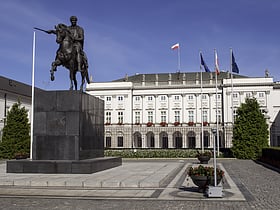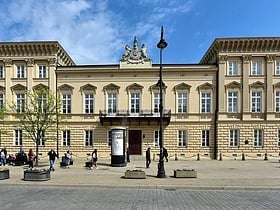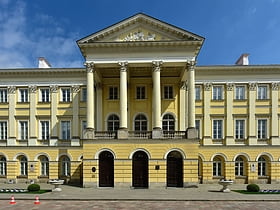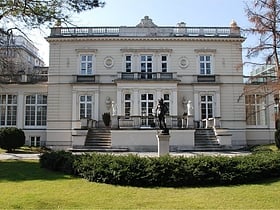Warsaw: Palace
Places and attractions in the Palace category
Categories
- Museum
- Palace
- Church
- Memorial
- Vernacular architecture
- Baroque architecture
- Street
- History museum
- Art museum
- Park
- Square
- Monuments and statues
- Specialty museum
- Shopping
- Historical place
- Neighbourhood
- Cemetery
- Concerts and shows
- Theater
- Shopping centre
- Bridge
- Science museum
- Universities and schools
- Architecture
- Library
- Forts and castles
- Skyscraper
- Tylman van Gameren
- Military museum
- Sacred and religious sites
- Sport
- Sport venue
- Music venue
- Nightlife
- Augustyn Wincenty Locci
- Area
- Neoclassical architecture
- Department store
- Natural history museum
- Arenas and stadiums
Wilanów Palace
Wilanów Palace, a resplendent gem nestled in the city of Warsaw, Poland, stands as a testament to the country's rich cultural and historical tapestry. Originally constructed for King Jan III Sobieski in the latter part of the 17th century, this Baroque masterpiece has...
Krasiński Palace
Baroque-style 17th-century palace Nestled in the heart of Warsaw, Poland, the Krasiński Palace stands as a majestic testament to the country's rich history and architectural grandeur. Built in the 17th century, this Baroque masterpiece was once referred to as the 'Palace of the Republic' due to its...
Brühl Palace
Brühl Palace, once a magnificent baroque edifice situated in the heart of Warsaw, Poland, stands as a poignant testament to the city's turbulent past. Erected in the 17th century for a Polish nobleman, Jerzy Ossoliński, the palace became the property of Heinrich von...
Saxon Palace
The Saxon Palace, once a magnificent example of Warsaw's architectural heritage, stands as a poignant reminder of the city's tumultuous past. Originally built in the 17th century, the palace was an emblem of Poland's aristocratic grandeur, with its classical façade...
Belweder
Classical palace and ex governmental seat Belweder is an iconic neoclassical palace in Warsaw, Poland, exuding historical significance and architectural elegance. Originally constructed in the 17th century, the palace has undergone several reconstructions, with the most notable one taking place in the early...
Presidential Palace
Palatial seat of Polish president The Presidential Palace in Warsaw, Poland, stands as an imposing and historic edifice in the heart of the city. This palatial structure serves as the official residence of the President of Poland, though it is primarily used for ceremonial purposes and state meetings.
Uruski Palace
Nestled in the historic district of Warsaw, Poland, Uruski Palace stands as a testament to the city's rich architectural heritage. This elegant palace, with its intricate facade and grand interiors, is a prime example of the Neo-Renaissance style that was popular among...
Copper-Roof Palace
Former residence of Polish royal family Nestled within the historic heart of Warsaw, the Copper-Roof Palace (Pałac Pod Blachą) stands as a testament to Poland's rich cultural heritage. This Rococo palace, characterized by its distinctive copper roof that lends it its name, is part of the Royal Castle...
Frederic Chopin Museum
Rebuilt mansion with a museum on Chopin Nestled in the heart of Warsaw, the Frederic Chopin Museum offers a profound journey into the life and legacy of Poland's most celebrated composer. Housed in the elegant Ostrogski Palace, a historical building that exudes charm and grandeur, the museum is a sanctuary...
Kazimierz Palace
Nestled in the heart of Warsaw, the Kazimierz Palace is a historic edifice that stands as a testament to the city's rich past. Originally constructed in the 17th century, the palace has undergone numerous transformations, serving various roles from a royal residence...
Jabłonowski Palace
The Jabłonowski Palace, situated in the heart of Warsaw, Poland, is a historic edifice that bears witness to the city's rich past. Originally constructed in the 18th century for the Jabłonowski family, this neoclassical palace has undergone various transformations...
Blank Palace
Blank Palace, a historical gem nestled in the bustling heart of Warsaw, Poland, stands as a testament to the city's rich past. Although less renowned than some of its European counterparts, this palace offers a unique glimpse into the architectural and cultural...
Sapieha Palace
Sapieha Palace is one of the palaces in Warsaw New Town district of Warsaw, Poland. Started by the powerful Sapieha family who gave the name to the building, it currently houses the Environmental Protection School Complex.
Palace of the Four Winds
The Palace of the Four Winds, also known as the Tepper Palace, is a rococo palace in Warsaw located at ulica Długa 38/40.
Deanery of St. John's Cathedral
The Deanery of St. John's Cathedral, Warsaw is a historic building located on ulica Dziekania in the Old Town of Warsaw, Poland. Since 2016 the Deanery has been the home of the Museum of the Archdiocese of Warsaw.
Młodziejowski Palace
Młodziejowski Palace Pałac Młodziejowskiego, Polish pronunciation:, also the Morsztyn Palace, is a palace located in Warsaw at 10 Miodowa Street, with annexes at 7 Podwale Street. The palace was erected in the Baroque style at the end of the 17th century. It is adjacent to the Branicki and Szaniawski palaces.
Michler's Palace
Michler's Palace or Michla's Palace was a townhouse in Warsaw located at Wolska Street no 40 in the Wola district. It was constructed in the late 19th century and destroyed during the Warsaw Uprising in 1944. It is known for an eponymous wartime song, Pałacyk Michla, which was written by poet and insurgent Józef Szczepański.
Mostowski Palace
Mostowski Palace is an 18th-century palace in Warsaw, Poland, located at ul. Nowolipie 2 — prior to World War II, at ul. Przejazd 15.
Sobański Palace in Warsaw
Sobański Palace - a historical building, located by Ujazdów Avenue in Warsaw, Poland. The building was constructed in 1876, under Polish architect Leandro Marconi's plans. In the nineteenth-thirtees, the palace's gardens were sold for the construction of a new road - the Avenue of Friends.
Kazanowski Palace
The Kazanowski Palace, also known as the Radziejowski Palace, was a large palace in Warsaw, occupying the place where the Charitable Center Res Sacra Miser stands today.
Primate's Palace
The Primate's Palace is a historical palace at the Senatorska Street in the Śródmieście district of Warsaw, Poland.
Sikorski Palace
The Sikorski Palace is a historical building located on ulica Srebrna in Warsaw, Poland. In 1877 the property was purchased by sculptor Aleksander Sikorski. In 1880 he built the palace, next to it locating his stonemason's workshop. Sikorski died the following year, and his children sold the palace to a nearby stonemason.
Konstanty Zamoyski Palace
The Konstanty Zamoyski Palace is a historic building on ulica Foksal in Warsaw, Poland.
Myślewicki Palace
The Myślewicki Palace is a rococo-neoclassical palace in Warsaw's Royal Baths Park. It was created for King Stanisław August Poniatowski as one of the first buildings in the Royal Baths. Its name derives from that of the nearby now nonexistent village of Myślewice.
Sugar Palace
The Sugar Palace is a historic building at 25 Mokotowska Street in Warsaw, Poland. It now houses the Adam Mickiewicz Institute.
Pac Palace
Pac Palace - a historical building, located by Miodowa Street in Warsaw, Poland.
Janasz Palace
The Janasz Palace is a historic building on ulica Zielna in Warsaw, Poland. It was built in 1870–80 for Jakub Janasz to a design by Jan Kacper Heurich. It suffered little in World War II and is the best preserved palace in Warsaw from the second half of the nineteenth century.
Potocki Palace
Potocki Palace, is a large baroque palace in Warsaw located at Krakowskie Przedmieście Street 15, directly opposite the Presidential Palace. It was originally built for Denhoff family and succeeded by Potocki family in the end of 18th century. After World War II the seat of the Ministry of Culture and Art.
Resursa Obywatelska Palace
Resursa Obywatelska Palace - a historical building, located by Krakowskie Przedmieście in Warsaw, Poland. The palace was designed by architect Edward Cichocki and built by Leon Karasiński between 1860 and 1861.
Lubomirski Palace
Lubomirski Palace is a palace in central Warsaw, which was built in the 18th century for the Radziwiłł family.
Tyszkiewicz Palace
Tyszkiewicz Palace, also known as Tyszkiewicz–Potocki Palace, is a rebuilt palace at 32 Krakowskie Przedmieście in Warsaw, Poland. It is one of the most beautiful Neoclassical-style buildings in the city.
Zamoyski Palace
Zamoyski Palace - a historical building, located by Nowy Świat Street in Warsaw, Poland. From 1667 the owner of the plot was Jan Wielopolski.
Staszic Palace
Staszic Palace is an edifice at ulica Nowy Świat 72, Warsaw, Poland. It is the seat of the Polish Academy of Sciences.
Branicki Palace
The Branicki Palace is an 18th-century magnate's mansion in Warsaw, Poland. It is located at the junction of Podwale and Miodowa Streets.
Palace of the Ministry of Revenues and Treasury
The Palace of the Ministry of Revenues and Treasury is located at 3/5 Bank Square in Warsaw. It is sometimes simply referred to as the Commission Palace.
Auditorium Maximum
The Auditorium Maximum - is a Classicist building located in the University of Warsaw's campus at 26/28 Krakowskie Przedmieście Street in Warsaw, Poland. The Auditorium Maximum was built in the nineteen-thirties, designed by architect Franciszek Eychorn.
Palace of Bishops of Kraków
The Kraków Episcopal Palace was the residence of the bishops of Cracow in Warsaw. It is located at 5 Miodowa Street.
Przebendowski Palace
Przebendowski Palace is a palace in Warsaw, built in the first half of the 18th century for Jan Jerzy Przebendowski. It is now located between the carriageways of the main road 62 "Solidarności" Avenue.
Map






































